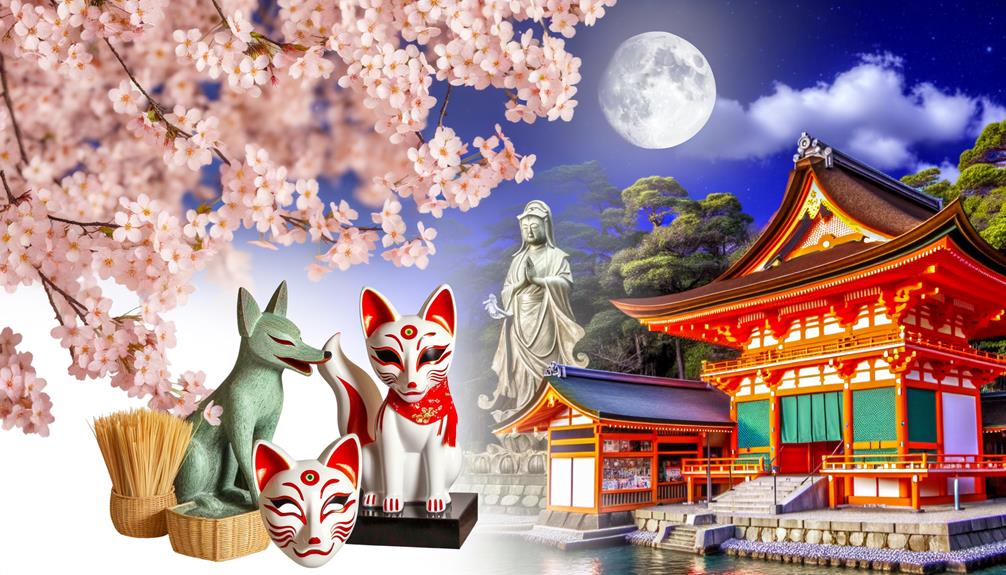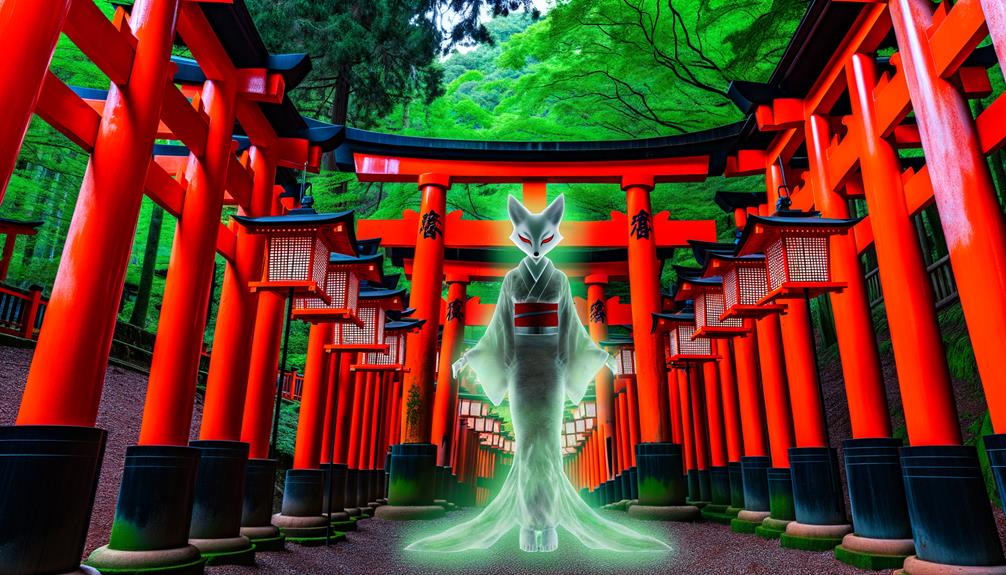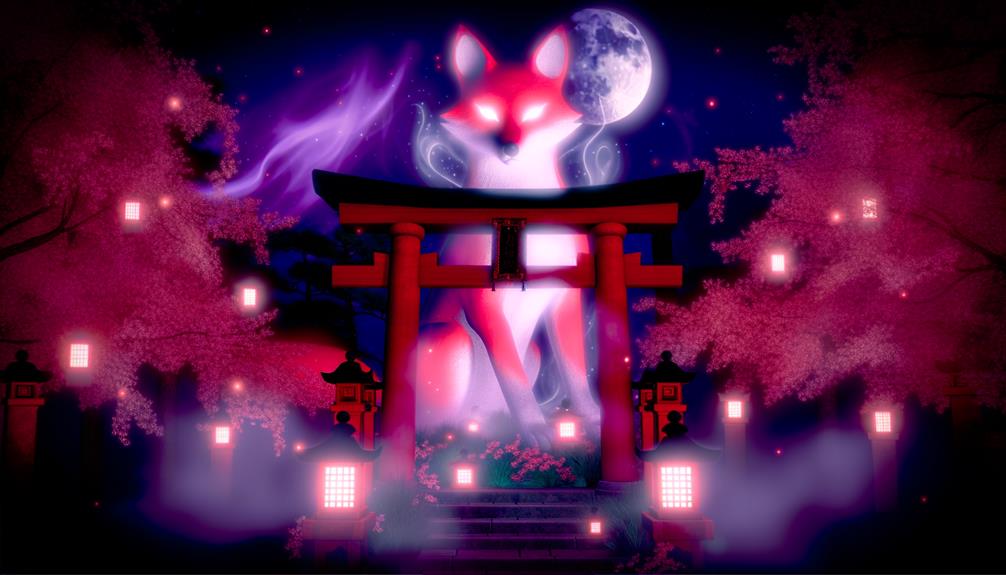Unraveling the complex tales of Japanese folklore is like stepping into a timeless, magical forest – each route leads to a story rich in tradition. I find myself increasingly captivated by the enchanting story of the Inari Fox God. This god is deeply rooted in the societal structure, and beautifully melds elements of Shintoism and Buddhism, touching upon wealth, farming, and human relationships. The fox, or 'kitsune' as the Japanese call it, acts as Inari's courier, adding a touch of mystery to this myth. But why does the fox hold such importance in this regard? And how has the reverence of Inari changed over the years, yet continues to resonate with the modern Japanese psyche? These are just a handful of the enticing questions we'll delve into.
Let's make this a bit more casual, like we're just having a chat. Picture stepping into a forest where each tree has a tale to tell – that's what Japanese folklore feels like. One story that always pulls me in is that of the Inari Fox God. This god is like a thread stitched into the very fabric of society and it's a cool mix of Shintoism and Buddhism. It touches on stuff like wealth, farming, and human relationships. The fox, which the Japanese call 'kitsune,' acts as Inari's postman, adding a dash of mystery to the whole thing. So why does the fox matter so much here? And how come people still feel a strong connection to Inari, even in today's Japan? These are just some of the intriguing questions we'll be looking into.
Origins of Inari Worship

Inari worship has deep roots in both Shinto and Buddhist ideologies. Its history can be traced back to the late 5th century. The adoration for this deity took a significant turn with the establishment of a shrine on Inari Mountain in 711 AD, and this adoration quickly spread during the Heian period. Inari, a respected Japanese deity, is often represented by a fox, a creature of great importance in Japanese folklore.
The inception of Inari worship is steeped in antiquity and mirrors the deep-seated importance of agriculture, especially rice farming in Japanese society. The Kanji characters for Inari, 稲荷, signify rice and cargo, acting as symbols of prosperity and success.
There's an impressive number of shrines dedicated to Inari across Japan, reflecting the deity's far-reaching impact. Notably, more than a third of all Shinto shrines in Japan pay homage to Inari. This reverence continues even in contemporary corporations, showing Inari's continued significance in today's society.
Inari carries a plethora of roles and is often worshipped as a trinity of deities, known as Inari sanza. Over the centuries, Inari has been seen as a patron of blacksmiths, a guardian for warriors, and a symbol of success and prosperity. This multifaceted deity's worship is intricately interwoven into Japanese culture.
Inari's Role in Shinto and Buddhism

Let's chat about the multifaceted role of Inari in Shinto and Buddhism. This deity is adored in both religious fields, showing its broad appeal and lively personality. The reverence for Inari started when the initial Inari shrine was erected on Inari Mountain in 711 AD, a key moment in the history of Japanese religion.
In Shinto, which is an indigenous Japanese belief system, Inari often takes the form of a Shinto kami, or deity, as per Japanese customs. Here, Inari is linked with foxes, fertility, wealth, and industry, giving it the title of the Rice Goddess and a protector of craftsmen.
In contrast, within Buddhist views, Inari is perceived as a facet of Avalokiteshvara, a bodhisattva tied with compassion. This vibrant attribute of Inari has led to the establishment of a large number of Inari shrines all over Japan, with Fushimi Inari Taisha being the most recognized.
Let's compare the two aspects:
| Shinto Kami | Buddhist Aspect |
|---|---|
| Rice Goddess | Avalokiteshvara |
| Protector of Craftsmen | Bodhisattva of Compassion |
| Connected with Foxes | – |
| Fertility & Wealth | – |
Hence, Inari's charm goes beyond the confines of Shinto and Buddhist doctrines, showing its universal role in Japanese religion.
Significance of Foxes in Inari Worship

Inari worship has deep roots in Japanese culture, with the fox, or "kitsune", playing a significant role in expressing the deity's qualities of wealth, achievement, and hard work. The white fox, an emblem of Inari, is depicted in many fox statues scattered around Shinto shrines, primarily in the famous Fushimi Inari Shrine, a popular site for pilgrims.
Here are a few reasons why foxes are so integral to Inari worship:
- As the messengers of Inari, foxes are often depicted in statues holding a key in their mouths, which is believed to unlock the rice storehouse.
- The association between Inari and the fox strengthens Inari's connection with agriculture and fertility.
- The iconic torii gates, a common sight at Shinto shrines in Japan, are considered to be under the protection of these foxes, which underlines their role as guardians.
Therefore, in Japanese culture, the fox is more than just an animal. It's a significant cultural symbol that embodies divine intervention, protection, and prosperity. By understanding this, we can gain a deeper insight into the relationship between Inari, the fox, and the Japanese people.
Contemporary Relevance of Inari

Curious about whether the worship of Inari still holds weight in our modern era? Even as Japanese society has embraced the future, the tale of the Inari fox god still carries significant weight today. Inari, known as a deity of prosperity and industry, is even sponsored by big businesses like Shiseido. This shows that Inari is not just a figure from a bygone era but plays a key role in today's business world.
The way people worship Inari has also evolved, reflecting the shifting spiritual needs of society. It offers a unique, personalized form of worship. You can see Inari's cultural impact in various aspects of modern life, from art and literature to pop culture icons like Pokémon.
Old traditions linked with Inari, like giving offerings of rice and sake, are still practiced today. This emphasizes the ongoing significance of Inari's symbols in present-day religious rituals. Plus, Inari is worshipped in over 32,000 shrines, including the famous Fushimi Inari-taisha on Inari Mountain. These locations draw crowds of visitors, showing how Inari continues to be important in our world.
Influence of Fushimi Inari Taisha

The lively red torii gates of Fushimi Inari Taisha, the most prominent Inari shrine, stand as a powerful symbol of the lasting influence of Inari, the fox god of rice, prosperity, and success, in Japanese tradition. Fushimi, located in the heart of Japan, has evolved into an icon of Inari's impact on the daily lives of the Japanese people. The seemingly endless rows of red torii gates, along with the red buildings, represent the divine presence of Inari.
To get a feel for the cultural weight of Fushimi Inari Taisha, here are some things to think about:
- The red torii gates: Individuals and businesses donate these gates in hopes of receiving blessings from Inari. They create a maze of faith that stretches across the shrine's hilly landscape.
- Inari's messengers: Foxes, also known as Inari's messengers, are a common sight in Fushimi. Statues of these foxes guard the shrines, reinforcing the idea that Inari is always present.
- The sheer number of shrines: The fact that one of Japan's most revered shrines is Fushimi speaks volumes about the widespread influence of Inari throughout Japan.
The ongoing popularity of Fushimi Inari Taisha highlights the deep cultural importance and broad respect for Inari in Japan. With its standout red torii gates and shrines, Fushimi keeps contributing to the cultural identity of Japan.
Frequently Asked Questions
What Is the Story of Inari the Kitsune?
Inari, a figure often represented as a fox or kitsune, holds a cherished place in both Shinto and Buddhist traditions. This deity is closely connected to wealth, farming, and warriors. There are numerous shrines across Japan that are devoted to honoring Inari.
What Is the Difference Between Inari and Kitsune?
Let's chat about Inari and Kitsune. They're not the same thing, you see. Inari is a deity in Shintoism, often shown as a fox, and is tied to ideas of fertility and prosperity. Kitsune, however, are seen as fox messengers for Inari. They're known for symbolizing a bountiful harvest and a sharp wit.
What Does the Inari Fox Symbolize?
From what I gather, the Inari fox is a symbol of prosperity, especially in the sectors of farming and manufacturing. This creature has ties to the growth of rice, suggesting an assurance of plentiful crops. The white foxes, also known as kitsune, are seen as bringers of good luck, a concept tied to the importance of Inari.
What Is the Myth of Inari?
So, you're curious about the Inari myth, right? Well, it's quite a story. Inari is a deity, or god, who is all about prosperity, success, and farming. Imagine this divine figure as a kind of celestial career coach, helping folks in all sorts of jobs. What's really interesting is how Inari is depicted – it's not just a man or a woman, but both. And you'll often see Inari with foxes, which are seen as a potent symbol of their power. Now isn't that something?

